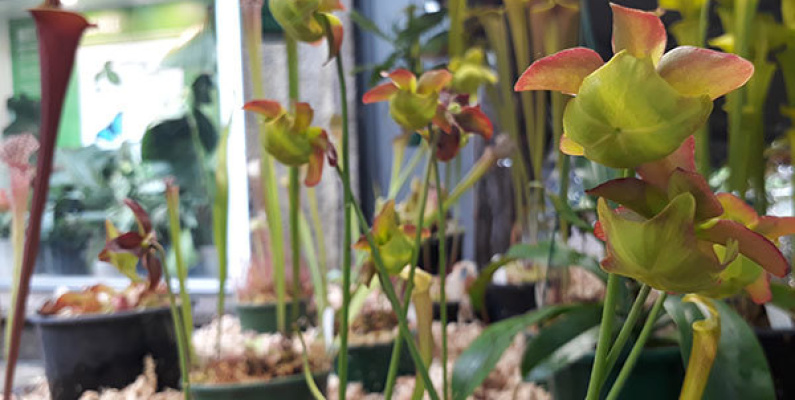
Carnivorous plants have evolved to be some of the hardiest plants on Earth – they have invaded environments where other plants cannot hope to grow. This bizarre behaviour is not a quest for energy, but for minerals and nutrients. Carnivorous plants still have leaves or other green surfaces for photosynthesis, but consuming animals allows these plants to grow in places where the soil is low in key elements like nitrogen or phosphorus. Instead of absorbing these minerals through their roots like most plants, their clever traps catch and digest prey that provides the lacking minerals.

Image: Venus flytraps, Dionaea muscipula, use a snap trap to capture prey, but the trap will only close if sensitive hairs are triggered five times in quick succession. By Kane Fleury © Otago Museum.
There is a huge diversity in the trapping mechanisms used to find prey. Pitfalls, lobster pots, snap traps, sticky flypaper and even bladders that open in under a millisecond help plants devour the animal kingdom. Some plants lace attractive droplets of nectar with sedatives to send wandering insects toppling to their doom, while some produce a surfactant that reduces the surface tension of water within pitfall traps, causing even the smallest insects to drown. Once captured, digestive enzymes produced by the trap turn prey into a soup that is easily absorbed by the walls of the plant.

Image: Sarracenia trumpet pitchers often use water-filled pitfall traps to drown and digest prey. By Kane Fleury © Otago Museum.
The type of prey targeted can be extremely variable. While insects are the most popular item on the menu, some plants have evolved more specialised targets, even working together with animals like mice, rats and crabs to supplement their diet in a way that is mutually beneficial. On Borneo, bats have evolved a symbiosis with the pitcher plant Nepenthes hemsleyana. The bats sleep during the day in specially designed "hotel" pitchers, and in exchange provide the plant with nitrogen-rich excrement.

Image: Nepenthes is the genus known as tropical pitcher plants, native to south-east Asia and especially diverse in Malaysia, Indonesia and the Philippines. By Kane Fleury © Otago Museum.
Carnivorous plants have evolved nine times independently, all across the globe – there are carnivorous plants on every continent except Antarctica. Even New Zealand has a few native sundew and bladderworts, although only two species are endemic here.
You can see our carnivorous plants display in the Tūhura Otago Community Trust Science Centre, open 10am to 5pm daily, admission applies.

Image: Drosera binata, the fork-leaved sundew is a native in New Zealand and Australia. By Kane Fleury © Otago Museum.
Top image: Sarracenia flower. Carnivorous plants also attract insects for innocent reasons – like most plants, they invest in attractive flowers to entice pollinators. By Kane Fleury © Otago Museum.
